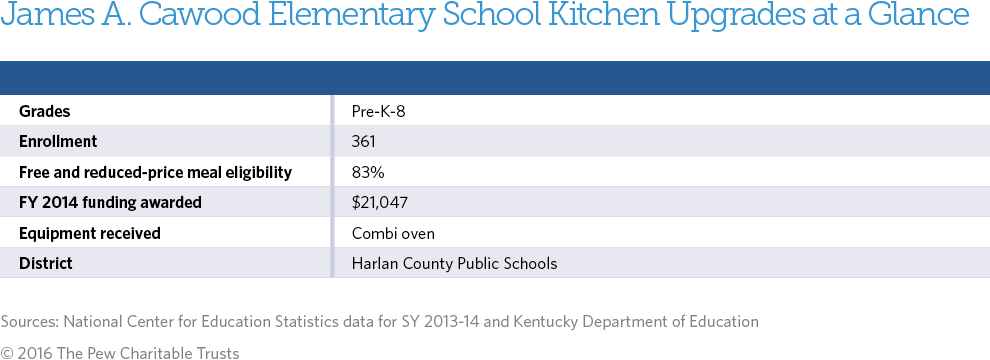James A. Cawood Elementary School
Harlan, Kentucky
Extending across miles of the Appalachian Mountains in Kentucky is the Harlan County school district, home to James A. Cawood Elementary School, where more than 8 in 10 students qualify for free or reduced-price lunches. Because of the rugged terrain and great distances between homes and the school, buses begin picking up Cawood students as early as 5:30 a.m. and often don’t return them home from after-school activities until 8 p.m. Jack Miniard, the district’s director of school nutrition, works to ensure that the children have access to healthy foods throughout those long days by offering traditional and second-chance breakfast, lunch, daily fresh fruit snacks, supper, summer meals, and a weekend backpack program. To meet that goal, he sought help from the U.S. Department of Agriculture in the form of a kitchen equipment grant for a new combi oven, a versatile piece of equipment that has improved the quality and appearance of the foods offered at Cawood each day.
“Our food has much better taste and quality since we began using the combi oven,” said Miniard. “Vegetables come out crunchy, not soggy, and chicken tenders are cooked evenly without burns. The kids really notice the difference.”
Previously, the school prepared meals with equipment that was over 30 years old. Vegetables were boiled, so they often turned mushy and lost much of their nutritional content. Meats took hours to cook and monopolized the ovens, so students had few menu options, and entrees were often overcooked because of unreliable equipment temperatures.

Combi ovens can tailor the style of cooking—steaming, roasting, or dehydrating—to each food item, which decreases the time and energy required of the kitchen staff. The more efficient cooking techniques let the staff focus instead on nutrition education, administrative tasks, and menu planning.
The school’s principal, John Carter, said the cafeteria improvements have helped to boost students’ academic performance. “Thanks to a dedicated staff and an engaged community, we have pulled the school up from the lowest ratings into the 88th percentile of the Kentucky Performance Rating for Educational Progress. And the cafeteria department has led the charge,” he said.
The food operation, which three years ago was a money-loser that offered preprocessed, heat-and-serve foods, now boasts a healthy budget and a nutritious menu that has moved toward fresh, local ingredients cooked from scratch, with plenty of fruit and vegetables that students enjoy. The quality meals and snacks are essential to the students’ diets and academic performance, especially because 88 percent of them eat a school lunch each day.
“The kids are eating more fresh produce, which is a real boon to local growers, a plus for the children’s health, and a much less expensive alternative to prepared and frozen vegetables,” said Miniard, summing up how one oven can make a huge difference. “Most importantly, we are able to offer them high-quality meals that they likely aren’t getting anywhere else.”


USDA’s School Kitchen Grants Benefit Meal Programs and Students
The right equipment makes a difference in efficient...
Learn More

School Nutrition Gets a Boost From USDA Kitchen Equipment Grants
School Nutrition Gets a Boost From USDA Kitchen Equipment Grants
Learn More





